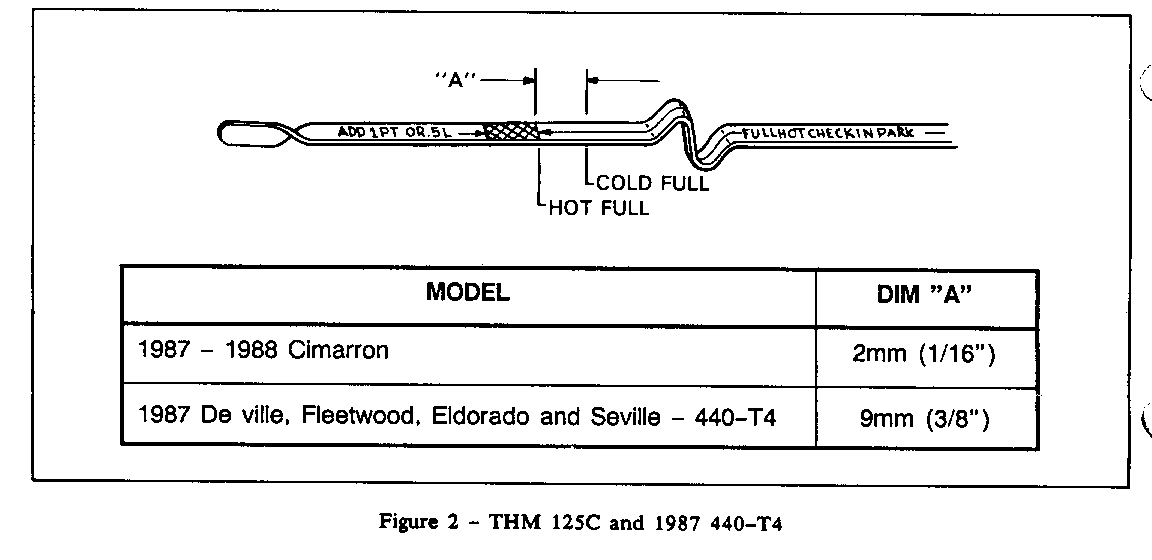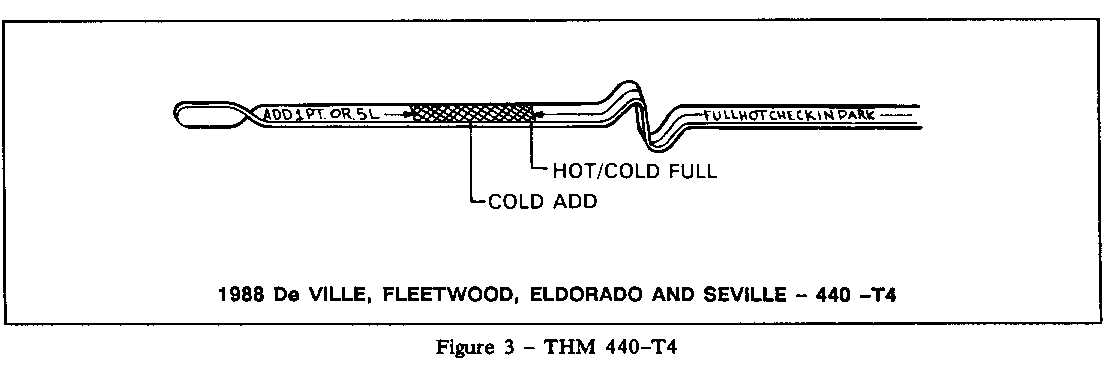TRANSMISSION AND TRANSAXLE FLUID CONDITION / CHECK

MODELS AFFECTED: 1987-1988 DE VILLES, FLEETWOODS, BROUGHAMS, ELDORADOS, SEVILLES, CIMARRONS, AND ALLANTES
This bulletin outlines the proper hot and cold fluid level checking procedures for automatic transmissions and transaxles used in 1987-1988 DeVilles, Fleetwoods, Broughams, Eldorados, Sevilles, Cimarrons, and Allantes.
Unless the transmission/transaxle (trans.) has been recently operated, a cold transmission fluid level check may be necessary to enable accurate diagnosis. A cold fluid level check CANNOT take the place of the hot (normal operating temperature) fluid level check procedure. The cold level check will only verify that there is enough fluid in the transmission to perform a road test to allow normal operating temperature to be reached safely prior to the NECESSARY hot check.
Preparation for Cold Fluid Level Check
1. Start the engine and let idle in PARK for three minutes on THM 440-T4 and F-7 transaxles. Start the engine and cycle gear range selector through 1, 2, D, OD, and R for approximately three seconds in each range. Complete the "COLD" check preparation by letting the engine idle in PARK for three minutes.
2. With vehicle level, accessories off, and engine idling in PARK, check the fluid level.
3. Fluid level should be checked as shown in Figures 1 through 4.
Preparation for Hot Fluid Level Check
1. Warm transmission/transaxle to normal operating temperawre, 80-93 DEG. C (180-200 DEG. F). This may take up to 15 miles of driving.
2. Park vehicle on level ground.
3. Apply parking brake and block wheels.
4. Start engine and move selector through all gear positions holding in "L" (LO) or first and in "R" (REVERSE) for a minimum of three seconds each.
5. Move gear selector to "P" (PARK).
6. Allow engine to idle for a minimum of three minutes in "PARK
NOTE: Inaccurate readings will result if fluid level is checked immediately after the vehicle has been operated:
- In high ambient temperawres above 32 DEG. C (90 DEG. F). - At sustained high speeds. - In heavy city traffic during hot weather - As a towing vehicle - In commercial service (taxi or police use).
Checking Fluid Level THM 200-4R (Figure 1)
When checking the fluid level on the THM 200-4R transmission "COLD" 16 to 32 DEG. C (60 to 90 DEG. F) a full transmission will show the fluid level to be BELOW the "add" mark on the fluid level indicator. As the transmission warms to normal operating temperature the fluid expands, raising the level to within the cross-hatched area.
THM 125C and 1987 440-T4 (Figure 2)
When checking the fluid level on the 125C and 1987 440-T4 transaxles "COLD", a full transaxle will show the fluid level to be ABOVE the "full" mark. This is the result of the fluid stored in the bottom pan when the transaxle is cold. As the transaxle warms to normal operating temperawre, fluid is captured in the side pan regulated by the thermo element, thus lowering the level to within the cross-hatched area.
1988 THM 440-T4 (Figure 3)
Note the appearance of the 1988 440-T4 transaxle fluid level indicator which has an extended cross-hatched area to include "COLD" level indication when full. The "COLD" level checking procedure remains the same as with the 1987 transaxle.
THM F-7 (Figure 4)
When checking the THM F-7 transaxle fluid level "COLD", a full transaxle will show just below the "FULL HOT" mark on the fluid level indicator. As the transaxle warms to normal operating temperawre, the fluid level will rise to the "FULL HOT" mark on the indicator.
While checking the fluid level, the fluid should also be checked for improper color, foaming, or unusual odor (refer to Figure 5).





General Motors bulletins are intended for use by professional technicians, not a "do-it-yourselfer". They are written to inform those technicians of conditions that may occur on some vehicles, or to provide information that could assist in the proper service of a vehicle. Properly trained technicians have the equipment, tools, safety instructions and know-how to do a job properly and safely. If a condition is described, do not assume that the bulletin applies to your vehicle, or that your vehicle will have that condition. See a General Motors dealer servicing your brand of General Motors vehicle for information on whether your vehicle may benefit from the information.
